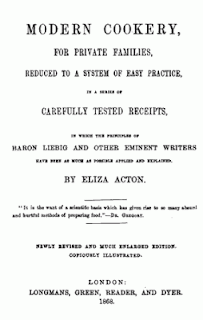Eliza Acton (1799-1859)
was a cook and poet. She was the first person write a cook book for normal folk
like you and I, all the previous ones were written for the housekeepers and
kitchen staff that ran houses and stately homes. Eliza was also the first to
include cooking times and ingredients lists in her recipes. Years later Mrs
Beeton based her much more popular book on Acton's writings. Cheeky!
This recipe comes from
her famous book Modern Cookery, for
Modern Families published in 1860. Old that it is, its simplicity seems quite
modern to me; there are very few ingredients, just sole, salt, cream, mace,
Cayenne pepper and lemon juice, and it was designed to show off the excellent
flavour of a delicate fish.
If you can’t get hold
of sole, use any other flat or white fish like brill, turbot, cod, haddock, pollack
etc., though they will need to be cooked for longer.
Her recipe starts: Prepare some very fresh middling soles with
exceeding nicety…
Ask the butcher to gut and scale a nice sole. At home, prepare it by trimming off the fins and place it in a close-fitting dish or pan. Pour around it boiling water that almost covers it, plus a teaspoon of salt, then let it simmer for just two minutes. Carefully pour away the water and pour in some cream so that it goes half way up the fish. Bring to a simmer and baste the fish with the hot cream until cooked through. This takes only four or five minutes, but if the cream thickens too much, let it down with some of the cooking liquid or some water.
Remove the sole to a serving dish and
finish the cream sauce by adding some salt
and a little ground mace and Cayenne pepper. Lift the sauce with a
squeeze of lemon juice – a little
under half a lemon did for me.
Pour the sauce over the fish and serve with
boiled potatoes and some blanched and buttered cucumber dice, says Jane, though
I expect it would work very well with a green salad or some quickly-steamed
asparagus spears.
#376 Eliza
Acton’s Sole Stewed in Cream. I loved this. The fish was lovely and moist
and it flaked away from the bone very easily. The sauce was not as rich as you
might expect, and its mild creaminess complemented the fish very well. There
was also the added bonus of finding a large and handsome roe within the sole
which also ate very well. Very good and very simple 8/10








